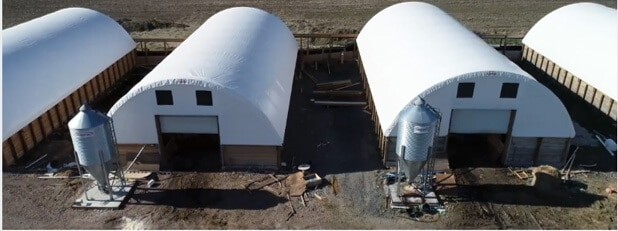Fabric Structures Reduce Swine Heat Stress
by Admin | Sep 12, 2019

Fabric buildings for swine can reduce heat stress. According to the University of Minnesota-Extension, just a few days of 80-degree temperatures can result in heat stress. For sows and boars, heat stress is more than simply being uncomfortable. Heat stress is a serious condition that results in long term health issues.
Swine Heat Stress Has Lasting Consequences
Newborn pigs thrive in a 95-degree environment. However, once pigs reach 12 pounds, the ideal temperature drops to 80 degrees. Breeding sows, boars, and growing-finishing pigs do best in even cooler environments.
In swine, heat stress creates a cascade of health problems. When a pig overheats, their blood flow moves more towards the peripheral parts of their body. This redirection of blood flow is the body’s attempt to regulate body temperature.
As a result, the blood vessels leading to the GI tract constrict. Thus, a pig experiencing heat stress will eat and drink less. A lack of nutrients and the resulting dehydration hits breeding sows and growing-finishing pigs particularly hard.
Breeding Sows
After experiencing heat stress, a sow may be infertile for a period of time. When breeding is successful, the risk of stillborn litters increases. Subsequent litters may be smaller, with lower piglet birth weights.
Piglets born to sows who experienced heat stress during pregnancy have been shown to have a higher core body temperature. This higher body temperature results in the piglets being more prone to heat stress. In addition, heat stress reduces a sow’s milk production, resulting in slower growth for the piglets.
Growing-Finishing Pigs
In the growing and finishing stages, pigs experiencing heat stress will have more fat growth. However, their overall body weight may be lower. These pigs will eat less and ultimately have reduced carcass quality. At market, these pigs will have inconsistent weights, hitting farmers directly in the pocketbook.
Reduce Heat Stress with a Fabric Structure
Fabric buildings for swine have several advantages over traditional counterparts. Unlike wood, concrete, or metal, fabric is thermally conductive. The interior of a fabric structure stays naturally cooler in the summer and warmer in the winter. Fabric buildings provide ideal housing all year long.
Fabric buildings for swine are well-built and the fabric is translucent. Sunlight filters through, creating a healthy, pleasant environment for both the swine and farm workers. Even indoors, the fabric buildings for swine can experience natural sunlight during the day. The need for artificial lighting is reduced, or even eliminated altogether.
In any livestock housing, ventilation is a concern. Several ventilation options are available in a fabric structure. End-wall panels allow fresh air to flow throughout the building. Vents placed higher up will draw out the hotter air as it rises. If active ventilation is desired, exhaust fans and vents can be installed.
In fabric buildings for swine, the interior is clearspan and free of any columns or posts. There’s plenty of room for swine to spread out. The interior can be customized by creating separate areas. Pregnant sows, or those with health concerns, can have their own designated areas. In farrowing pens, piglets are kept safe and protected near the sows, while still experiencing natural sunlight and fresh air.


